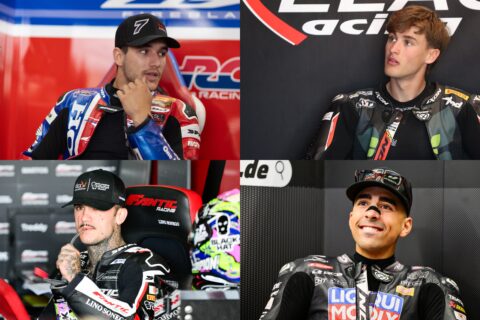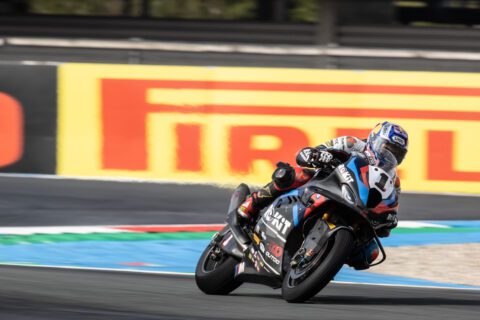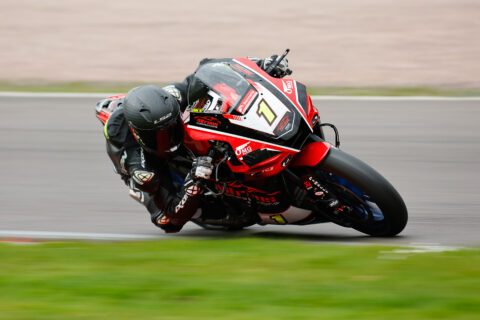Yamaha’s Pro-Am Challenge was the maddest one-make race series ever held. The concept was simple: Yamaha supplied 24 identical RD350 machines to invited riders - a mix of professional and club racers – who would then pick an ignition key out of a hat to be allocated one of the bikes for the weekend. With no possible machinery advantage to be had, the result of every race came down to the best rider on the day – and often the wildest.
Racing in Pro-Am was not for the feint-hearted. Riders would grab the pillion rails of rival’s bikes to get a tow, they would dab each other’s front brakes, grab the left-hand front fork or stretch a leg out over the pillion seat for better aerodynamics on the straights, and generally act like escaped lunatics on two wheels.
The series provided some of the closest cut-and-thrust racing ever seen on UK circuits and it made stars out of the likes of Niall Mackenzie, Alan Carter, and Kenny Irons. It was even contested by a young Damon Hill who would go on to win the Formula 1 car racing world title in 1996.
The Pro-Am series also launched the careers of several behind-the-scenes men like Lin Jarvis (now Yamaha MotoGP team boss), Dave Hancock (now top brass at Honda Europe) and Andrew Smith (now product director at Yamaha Europe).
It’s been 31 years since the last Yamaha Pro-Am race was staged but now the series is making a dramatic comeback after appearing as a very special support race at this year’s British Grand Prix at Silverstone.
Incredibly, the race organisers managed to track down, buy, and fully restore, 24 Yamaha RD250s (the original series used 350s but getting hold of large numbers of 250s proved more feasible) and invited many of the original Pro-Am riders and some special guest riders, to return to the track and relive their youth by doing battle one more time.
A bunch of 50-plus retired racers with one last chance to prove who’s fastest? What could have possibly gone wrong? Very little, in fact, bar a few teething problems with some of the bikes and the odd crash or two the race turned out to be a success at a rainy Silverstone.
Mackenzie took the victory with an excellent ride and he told Bikesport News just how much of a pleasure it was to be back out there again, competing alongside men he hadn’t seen since the last of his Pro-Am races in the 80s.
“Well, I was sitting on the grid thinking what have I done here? But once the lights went out, I just got my head down and said I’ll wait and see what happens,” began the Scotsman. “Fortunately I got away good and there was a bit of carnage behind me, it was raining on the Sunday so it was a bit slippy and some of the guys got a bit excited.
“There was a few collisions on the first lap so it let me off the hook a wee bit, which helped. There was always going to be some incidents – definitely! I mean, all the guys, a lot of them haven’t raced for a wee while but they were still up for having a go.
“I didn’t really get involved in a lot of it but in practice it was all a bit close with everybody rushing past each other but there was no grabbing kill-switches or anybody else’s bike – I think everybody had enough to do just getting their heads around riding the bikes again.
“I was working at Silverstone, so I couldn’t do a lot of partying but the guys were definitely partying every night so they were getting back into the swing of things from the old days.
“There’s a lot of guys who are still very fit people, like Charlie Corner, Geoff Crust, Curt Langan. They were all determined back in the day and I knew they wouldn’t be any different and they were still pretty much the same people I remember from 20 years ago.
“A lot of them I haven’t seen since the 80s so it was just like a school reunion really. One or two of them I would have seen now and again but most of them – over 20 of them – I hadn’t seen for 20-odd years.”
The original Yamaha Pro-Am Challenge was held from 1981 to 1984 and was the brainchild of several people, including Andrew Smith who is now Director (Product PV) for Yamaha Europe.
“I was involved from the very start,” he began. “I was working for a company called TW Promotions that first worked with Dunlop tyres then got involved with racing promotions for Yamaha UK. A guy called Robert Jackson was also involved. He was the man responsible for bringing Barry Sheene over to Akai Yamaha in 1980 and one of the men working for Jackson was Lin Jarvis who is now managing director for Yamaha Racing in MotoGP.
“Between us we started running the Pro-Am series for Yamaha. Dave Owen (owner of TW Promotions), Bruce Cox (owner of Performance Sports Ltd), Robert Jackson, and Steve Hackett (Yamaha marketing) were also involved so it was a sort of joint committee.
“We’d been looking at a number of motocross events, where most of the bikes were standard, and wondered about doing a one-make Yamaha series. Then we thought ‘Why not try that in road racing?’
“It was then decided that if we were going to do that it should be done to launch a product and what better product was there than the Yamaha RD350? We also decided it had to be all-encompassing so there was no chance of any individual rider with a rich father or sponsor gaining an advantage through tuning their bike.
“It had to be equal bikes and equal tyres so that the series was down to pure talent. Yamaha would look after the bikes and take them to the circuits and riders would literally pick a key out of a hat to select their bike so it would be absolutely bog standard.”
One of the biggest stars to emerge from the Pro-Am series, Mackenzie says the concept worked perfectly. “The idea was to put the emphasis on rider skill rather than machine superiority and it worked brilliantly.”
Another big name to emerge from the series, Alan Carter, agrees. In 1983, Carter became the youngest rider ever to win a Grand Prix when he won the 250cc race at Le Mans aged just 18. “That kind of one-make race series has been copied a lot with things like the Harley-Davidson XR1200 Challenge and the Yamaha R6 Cup but nothing has worked quite as well.”
And work Pro-Am did. Race day spectators and ITV World of Sport viewers were captivated by the kind of no-holds-barred, full-contact racing that made Grands Prix look lame. The Pro-Am race became the highlight of every meeting it appeared at. “Once we got TV exposure it was enormous,” Smith said. “At the races, all the top riders and sponsors came out of the garages and into pit lane to watch the Pro-Am race because it was, literally, fairing-bashing all the way.”
In Pro-Am, anything went. “We got up to stuff that you’d never get away with in any other racing class,” Mackenzie said. “We used to dab each other’s’ front brakes going along the straights, pull on the pillion grab rail of the rider in front to get a tow, and even hold our own front forks or stretch a leg out over the pillion seat to make a more aerodynamic shape on the bike.”
With such extreme riding techniques, crashes were inevitable. Fortunately, Yamaha picked up the bill for those as well. “The spares budget was probably the biggest part of the financial commitment on behalf of Yamaha!” Smith admitted. “But we eventually renovated the bikes back into road-legal trim and sold them through dealers.”
And besides all the action on-track, a paddock full of testosterone-fuelled teenagers ensured there was further entertainment at every round. “All the lads who raced in the series were pals so we’d have a few pints, try to screw a few birds, and race our motorbikes,” Carter laughed. “I mean, what more could you want from a weekend? It was like the pinnacle of life.”
The series came to a natural end in 1984 when it had effectively served its purpose in promoting the RD350LC. There have been many one-make series since then – beginning with Honda’s own CBR Challenge in 1987 – but none have caught the imagination quite like Pro-Am.
“No-one has really run a one-make race series the way we did,” Smith explained. “We did it the most costly way, for sure, by taking responsibility for all the bikes. It was a costly operation but it was a win-win situation for everybody involved.”
Some 31 years after the last Yamaha Pro-Am race, many of the original stars lined up on the grid as part of the British Grand Prix at Silverstone to relive their youths and re-discover their competitive spirit. 24 invited riders (see entry list) competed on identical Yamaha RD250s, having picked the keys out of a hat just as they did in the old days.
According to Mackenzie, plans are in motion to make the event a regular thing over the next couple of years, with jaunts to Europe – where the series also gained attention – being mooted for 2016 alongside another British date.
“We’ll get the bikes all prepped, and then try and make some plans,” he told Bikesport News. “The bikes are all there now, and it’s a complete package, so they’re really keen to do a bit more. They’ve got 30 bikes but there will only ever be 24 on the grid.
“There’s no dates in the diary but they’ll definitely have two or three events next year. The series was big in France and Germany as well, so they’re keen to maybe do an international event. In addition there’ll be at least one in the UK next year, but at the moment we just have to play it by ear.”


![Shane Byrne, Monstermob Ducati, 2003 WorldSBK, action [Gold & Goose]](https://bikesportnews.com/wp-content/uploads/2025/07/Shane-Byrne-Monstermob-Ducati-2003-WorldSBK-action-Gold-Goose-480x272.jpg)







